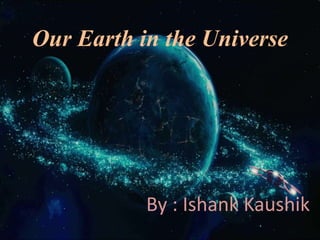Our earth in the universe
•Download as PPTX, PDF•
1 like•1,977 views
Our earth in the universe
Report
Share
Report
Share

Recommended
Recommended
More Related Content
What's hot
What's hot (20)
YEAR 9 GEOGRAPHY - ASTRONOMY: SUN, PLANETS AND GALAXY

YEAR 9 GEOGRAPHY - ASTRONOMY: SUN, PLANETS AND GALAXY
Similar to Our earth in the universe
Similar to Our earth in the universe (20)
ICSE Class VIII Physics The Universe - TopperLearning

ICSE Class VIII Physics The Universe - TopperLearning
Stars and the solar system/ class8 / science / physics / ncert

Stars and the solar system/ class8 / science / physics / ncert
Recently uploaded
Recently uploaded (20)
ICT role in 21st century education and it's challenges.

ICT role in 21st century education and it's challenges.
HMCS Max Bernays Pre-Deployment Brief (May 2024).pptx

HMCS Max Bernays Pre-Deployment Brief (May 2024).pptx
Exploring_the_Narrative_Style_of_Amitav_Ghoshs_Gun_Island.pptx

Exploring_the_Narrative_Style_of_Amitav_Ghoshs_Gun_Island.pptx
General Principles of Intellectual Property: Concepts of Intellectual Proper...

General Principles of Intellectual Property: Concepts of Intellectual Proper...
Plant propagation: Sexual and Asexual propapagation.pptx

Plant propagation: Sexual and Asexual propapagation.pptx
On National Teacher Day, meet the 2024-25 Kenan Fellows

On National Teacher Day, meet the 2024-25 Kenan Fellows
Unit 3 Emotional Intelligence and Spiritual Intelligence.pdf

Unit 3 Emotional Intelligence and Spiritual Intelligence.pdf
Basic Civil Engineering first year Notes- Chapter 4 Building.pptx

Basic Civil Engineering first year Notes- Chapter 4 Building.pptx
Interdisciplinary_Insights_Data_Collection_Methods.pptx

Interdisciplinary_Insights_Data_Collection_Methods.pptx
Our earth in the universe
- 1. Our Earth in the Universe By : Ishank Kaushik
- 2. What is the universe? The universe is….basically, everything. Scientifically, it’s defined as the totality of everything that exists, including all physical matter and energy, ranging from the smallest atom to the biggest galaxy—the planets, stars, everything
- 3. Kinds of Galaxies Some galaxies are very small with only a few million stars. While other could have as many as 400 billion stars, or even more. There are three kind of galaxies, Spiral, Elliptical, and Irregular. The only difference between the three is what shape they are. Spiral Elliptical Irregular
- 4. A hundred to four hundred billion stars
- 5. 5 The Milky Way as seen from the Enterprise A hundred thousand light years across Light would take 1,00,000 years to travel across the galaxy.
- 6. What is our Solar System? Our solar system consist of central star (the Sun), the eight planets orbiting the sun, moon, asteroids, comets, meteors, interplanetary gas, dust, and all the “space” in between them. The eight planets of the Solar System are named of Greek and Roman Gods and Goddesses.
- 7. PLANETS Planets are large celestial objects which revolve around the sun in close elliptical paths are called orbits. The eight planet of solar system are :- a)Mercury b)Venus c)Earth d)Mars e)Jupiter f)Saturn g)Uranus h)Neptune Planets have no light of own. A planet is made up of rock & metal, or gas. All the planets revolve around the sun are also rotate on its axis.
- 9. STARS • Stars are the celestial objects that are extremely hot & have light of their own. • The stars appear to be small because they are very, very far away from us. • The “SUN” is the star which is nearest tot the earth. The sun looks much bigger and brighter because it is much nearer to us than any other star.
- 10. What is Constellations? • The group of stars which appears to form a recognisable pattern is known as constellations. Each constellation has been given a name signifying an animal, a human being or some other object which it appears to resemble. • Some of the important constellations which can see during night sky are ursa major, orion, cassiopeia, leo major
- 11. The SUN The sun is a star. It is a star around earth & other planet which revolve. The sun is a star having a system of planets around it with life of one of its planets “EARTH”. The sun is a extremely hot object having temperature 6000 degree celsius. The sun is not a solid object. The sun consist of mostly hydrogen gas. The sun is the main source of heat and light energy for all the planets of the solar system & their satellites.